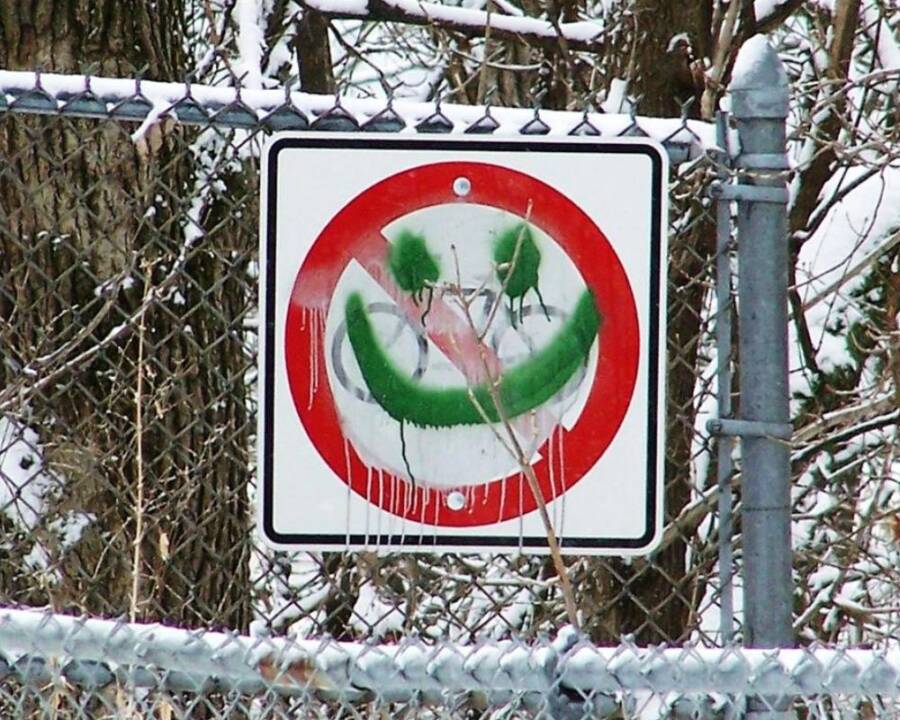Since 1997, at least 45 young men have mysteriously disappeared after a night at the bar only to be found dead in a nearby body of water — and some believe the shadowy Smiley Face Killer is to blame.
Between 1997 and 2017, authorities pulled the dead bodies of more than 40 young men out of rivers and lakes in more than 25 cities across 11 states. Most of them were college-aged, popular, and athletic. Nearly all the men had last been seen leaving bars or parties while inebriated.

Twitter (X)The bodies of at least 45 young men were pulled from bodies of water over an 11-year period — and in many cases there were smiley faces painted nearby.
Time and again, police understandably theorized that the men had become too drunk, wandered too close to the water, and simply fallen in with no hope of climbing out in their intoxicated state.
But in 2008, two retired New York City police officers-turned-private investigators who’d been looking into the deaths announced their eerie findings. Painted on walls near the locations where at least a dozen of the bodies were found was the same symbol over and over: a smiley face.
Given the presence of the graffiti and the similarities among the victims, the two investigators insisted that the deaths had been the work of a serial murderer (or gang of murderers) now widely known as the Smiley Face Killer.
“They’re psychopaths,” one of the investigators said of the murderer, or murderers, at the time. “They have no remorse.”
But is the Smiley Face Killer really out there — or was there never any murderer at all?
Inside The First Smiley Face Killer Murder
The investigators responsible for popularizing the Smiley Face Killer theory in 2008, Kevin Gannon and Anthony Duarte, based a significant amount of their theorizing on the disappearance of Fordham University student Patrick McNeill in New York City on Feb. 16, 1997.
That night, McNeill was last seen leaving a bar called the Dapper Dog on Manhattan’s Upper East Side. McNeill’s friends and family members searched tirelessly for him alongside police until April 7, when his body was found floating in the water near a pier in the Bay Ridge area of Brooklyn.

Morbid Podcast/InstagramPatrick McNeill was 21 years old when he died in 1997.
It seemed like an accidental drowning, but Gannon disagreed. He vowed to the young man’s parents that he would discover the truth. After retiring from the New York Police Department in 2001, he enlisted Duarte, his old partner, and they set out to learn what had happened to McNeill — and the other young men who had died under similar circumstances — under the banner of their Nationwide Investigations firm.
Their official report in the case of McNeill found copious evidence suggesting that someone had killed him and then placed him in the water: intoxication consistent with drugging, a car seen following him after he left the bar, ligature marks on his neck, charring on his head and torso, and the fact that his body’s position in the water was inconsistent with a typical drowning incident.
Therefore, Gannon and Duarte concluded that McNeill had been stalked, drugged, abducted, bound, burned, killed, and dumped in the water. The two detectives were sure they had a murderer on their hands — and that McNeill was far from the only victim.
Untangling The Smiley Face Killer Theory
While the Patrick McNeill case may have ignited Gannon and Duarte’s suspicions, they began working on the Smiley Face Killer theory even more intensely after learning about other young men who had died in eerily similar ways.
Gannon and Duarte were now more sure than ever that they were chasing a serial killer — or killers. Furthermore, they suggested that this Smiley Face Killer may have been motivated to murder out of envy.

Michael Appleton/NY Daily News Archive via Getty ImagesKevin Gannon (left) and Anthony Duarte (right).
Duarte told CNN in 2008 that the killer was likely “the opposite [of the victims], not smart, someone not good in school, maybe doesn’t have a job, not popular,” and lashed out by drugging and murdering the men before dumping their bodies in the water.
In addition to killing their victims, the Smiley Face Killer was believed to have left their signature behind at the scene. Perhaps they were signing their work, as it were, or taunting police. However, any other significance of the symbol remains unclear — as does the explanation for the occasional appearance of the word “Sinsinawa” at some of the death scenes.
While such elements of the case remained a mystery, the investigators believed they’d finally caught a break in 2006.
A University of Minnesota student named Christopher Jenkins had been pulled out of the Mississippi River in Minneapolis after a night of bar-hopping with friends four years earlier, and his official cause of death was listed as accidental drowning. But the detectives believed that he fit the victim profile for their Smiley Face Killer.
His parents did not accept the official version of events and insisted that foul play had been involved in their son’s death. “He was loaded into a vehicle, a van, driven around and eventually murdered,” his mother, Jan Jenkins, told CNN. “He was murdered and thrown away like a piece of trash.”

Twitter (X)Christopher Jenkins vanished after leaving a Halloween party in 2002.
It was in 2006 that an informant finally came forward in prison and gave police enough information regarding Jenkins’ demise that they officially changed his cause of death from accidental drowning to homicide.
Nevertheless, the Minneapolis police came out and said that they didn’t believe that a serial killer was responsible for Jenkins’ death — or for the dozens of other deaths that Gannon and Duarte had folded into their Smiley Face Killer theory.
So, does this mysterious murderer really exist?
Evidence For And Against The Smiley Face Murders
While Gannon and Duarte turned up a wealth of disturbing details over the years, the fact remains that the theory of the Smiley Face Killer has been widely discredited.
The police departments involved do not officially treat these deaths as part of a serial killer investigation. Law enforcement aside, the Minneapolis nonprofit Center for Homicide Research (CHR) released a thorough report on the Smiley Face Killer theory in 2010 that firmly debunked the entire idea.
In addition to citing law enforcement and criminal justice experts who believe there’s no serial killer, the researchers investigated the cases themselves. They came up with a list of 18 reasons why they’re sure there’s no Smiley Face Killer.
According to the CHR, most of the victims displayed no evidence of physical trauma or drugging, while the circumstances did indeed suggest accidental drowning. Moreover, they point to the absence of motive or any hard evidence actually linking the deaths.

Going West Podcast/InstagramThe Center for Homicide Research states that none of the smiley faces reportedly found near the bodies of more than a dozen victims matched each other — so they weren’t drawn by the same killer.
As for the smiley faces, the researchers state that they’re not consistent with each other, were never proven to have been made around the times of the deaths, and don’t reliably occur within close proximity to the death scenes. Experts also say that “Sinsinawa” is a Native American word meaning “rattlesnake” that often appears in graffiti across the Midwest.
However, Gannon and Duarte have stood by their theory, insisting that the cases are linked and that the Smiley Face Killer is still at large. But if the CHR is correct and there is no killer, then why are people so willing to believe there is?
As the researchers wrote in their paper, “Throughout history, society has always needed to produce monsters… to help explain the unexplainable.”
After this look at the Smiley Face Killer theory, discover the most disturbing quotes ever uttered by serial killers. Then, read up on the horrifying crimes of Ed Kemper, the “Co-ed Killer.”





